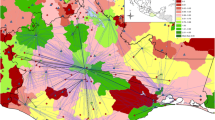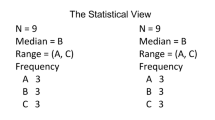Abstract
With advances in spatial analysis techniques, there has been a trend in recent public health research to assess the contribution of area-level factors to health disparity for a number of outcomes, including births. Although it is widely accepted that health disparity is best addressed by targeted, evidence-based and data-driven community efforts, and despite national and local focus in the U.S. to reduce infant mortality and improve maternal-child health, there is little work exploring how choice of scale and specific GIS visualization technique may alter the perception of analyses focused on health disparity in birth outcomes. Retrospective cohort study. Spatial analysis of individual-level vital records data for low birthweight and preterm births born to black women from 2007 to 2012 in one mid-sized Midwest city using different geographic information systems (GIS) visualization techniques [geocoded address records were aggregated at two levels of scale and additionally mapped using kernel density estimation (KDE)]. GIS analyses in this study support our hypothesis that choice of geographic scale (neighborhood or census tract) for aggregated birth data can alter programmatic decision-making. Results indicate that the relative merits of aggregated visualization or the use of KDE technique depend on the scale of intervention. The KDE map proved useful in targeting specific areas for interventions in cities with smaller populations and larger census tracts, where they allow for greater specificity in identifying intervention areas. When public health programmers seek to inform intervention placement in highly populated areas, however, aggregated data at the census tract level may be preferred, since it requires lower investments in terms of time and cartographic skill and, unlike neighborhood, census tracts are standardized in that they become smaller as the population density of an area increases.



Similar content being viewed by others
References
Szwarcwald, C. L., Andrade, C. L., & Bastos, F. I. (2002). Income inequality residential poverty clustering and infant mortality: A study in Rio de Janeiro, Brazil. Social Science & Medicine, 55, 2083–2092.
Moore, D. A., & Carpenter, T. E. (1999). Spatial analytical methods and geographic information system: Use in health research and epidemiology. Epidemiologic Reviews, 21(2), 143–161.
Carlos, H. A., Shi, X., Sargent, J., Tanski, S., & Berke, E. M. (2010). Density estimation and adaptive bandwidths: A primer for public health practitioners. International Journal of Health Geographics, 9, 4.
Reijneveld, S. A., Verheij, R. A., & de Bakker, D. H. (2000). The impact of area deprivation on differences in health: Does the choice of the geographical classification matter? Journal of Epidemiology and Community Health, 54(4), 306–313.
Stopka, T. J., Krawczyk, C., Gradziel, P., & Geraghty, E. M. (2014). Use of spatial epidemiology and hot spot analysis to target women eligible for prenatal women, infants, and children services. American Journal of Public Health, 104(S1), S183–S189.
Dai, D., Zhang, Y., Lynch, C. A., Miller, T., & Shakir, M. (2013). Childhood drowning in Georgia: A geographic information system analysis. Applied Geography, 37(1), 11–22.
Wilson, S., Burwell-Nany, K., Jiang, C., Zhang, H., Samantapudi, A., Murray, R., et al. (2015). Assessment of sociodemographic and geographic disparities in cancer risk from air toxics in South Carolina. Environmental Research, 140, 562–568.
McKernan, S., Kuthy, R. A., Hanley, P. F., Jones, M. P., Momany, E. T., McQuistan, M. R., et al. (2015). Geographic variation of dental utilization among low income children. Health and Place, 34, 150–156.
Morgenstern, H. (1995). Ecologic studies in epidemiology: Concepts, principles, and methods. Annual Review of Public Health, 16, 61–81.
Blake, S. B. (2014). Spatial relationships among dairy farms, drinking water quality, and maternal-child health outcomes in the San Joaquin Valley. Public Health Nursing, 31(6), 492–499.
Reader, S. (2001). Detecting and analyizing clusters of low birth weight incidence using exploratory spatial data analysis. Geo-Journal, 53, 2.
Krieger, N., Waterman, P. D., Chen, J. T., Soobader, M., & Subramanian, S. (2003). Monitoring socioeconomic inequalities in sexually transmitted infections, tuberculosis, and violence: Geocoding and choice of area-based socioeconomic measures—The Public Health Disparities Geocoding Project (US). Public Health Reports, 118, 240–258.
Whitman, S., Silva, A., Shaw, A., & Ansell, D. (2004). Diversity and disparity: GIS and small-area analysis in six Chicago neighborhoods. Journal of Medical Systems, 28(4), 397–411.
Polednak, A. P. (1991). Black–white differences in infant-mortality in 38 standard metropolitan statistical areas. American Journal of Public Health, 81, 1480–1482.
Bell, J. F., Zimmerman, F. J., Almgren, G. R., Mayer, J. D., & Huebner, C. E. (2006). Birth outcomes among urban African-American women: A multilevel analysis of the role of racial residential segregation. Social Science and Medicine, 63(12), 3030–3045.
DeGraaf, J. P., Steegers, E. A., & Bonsel, G. J. (2013). Inequalities in perinatal and maternal health. Current Opinion Obstetrics and Gynecology, 25, 98–108.
Anthopolos, R., James, S. A., Gelfand, A. E., & Miranda, M. L. (2011). A spatial measure of neighborhood level racial isolation applied to low birthweight, preterm birth, and birthweight in North Carolina. Spatial and Spatio-Termporal Epidemiology, 2(4), 235–246.
Christian, L. M., Glaser, R., Porter, K., & Iams, J. D. (2013). Stress-induced inflammatory responses in women: Effects of race and pregnancy. Psychosomatic Medicine, 75(7), 658–669.
Jimenez, M. P., Osypuk, T. L., Arevalo, S., Tucker, K. L., & Falcon, L. (2015). Neighborhood socioeconomic context and change in allostatic load among older Puerto Ricans: The Boston Puerto Rican health study. Health and Place, 33, 1–8.
Ebener, S., Guerra-Arias, M., Campbell, J., Tatem, A. J., Moran, A., Johnson, F. A., Fogstad, H., et al. (2015). The geography of maternal and newborn health: The state of the art. International Journal of Health Geographics, 14, 19.
Love, C., David, R. J., Rankin, K. M., & Collins Jr., J. W. (2010). Exploring weathering: Effects of lifelong economic environment and maternal age on low birth weight, small for gestational age, and preterm birth in African-American and white women. American Journal of Epidemiology, 172(2), 127–134.
Diez-Roux, A. V., Nieto, F. J., Muntaner, C., Tyroler, H. A., Comstock, G. W., Shahar, E., & et al. (1997). Neighborhood environments and coronary heart disease: A multilevel analysis. American Journal of Epidemiology, 146(1), 48–63.
U.S. Census Bureau. Retrieved September 15, 2015, from https://www.census.gov/newsroom/releases/archives/governments/cb12-161.html.
U.S. Census Bureau. State and County QuickFacts: Kalamazoo city. Retrieved July 7, 2015, from http://quickfacts.census.gov/qfd/states/26/2642160.html.
Michigan Geocoded Birth File, Division for Vital Records and Health Statistics, Michigan Department of Health and Human Services. (2013). Retrieved July 7, 2015, from http://www.mdch.state.mi.us/pha/osr/CHI/Births/frame.html.
Centers for Disease Control Pregnancy Risk Assessment Monitoring System (PRAMS). (2015). https://chronicdata.cdc.gov/health-area/maternal-child-health.
Beale, L., Abelin, J., Hodgson, S., & Jarup, L. (2008). Methodologic issues and approaches to spatial epidemiology. Environmental Health Perspectives, 116, 1105–1110.
City of Kalamazoo, Neighborhoods. Retrieved November 16, 2016, from http://www.kalamazoocity.org/about-kzoo/neighborhoods.
Britton, M. L., & Shin, H. (2013). Metropolitan residential segregation and very preterm birth among African American and Mexican-origin women. Social Science and Medicine, 98, 37–45.
Author information
Authors and Affiliations
Corresponding author
Ethics declarations
Conflict of interest
The authors declare that they have no conflict of interest.
Rights and permissions
About this article
Cite this article
MacQuillan, E.L., Curtis, A.B., Baker, K.M. et al. Using GIS Mapping to Target Public Health Interventions: Examining Birth Outcomes Across GIS Techniques. J Community Health 42, 633–638 (2017). https://doi.org/10.1007/s10900-016-0298-z
Published:
Issue Date:
DOI: https://doi.org/10.1007/s10900-016-0298-z




